List of toxic mushroom species
There are 119 poisonous fungus species listed below.
This is a compendium of poisonous fungi. See also mushroom poisoning.
There are 119 poisonous fungus species listed below.
| Scientific name | Common name | Distribution | Picture |
|---|---|---|---|
| Agrocybe arenicola | Europe | ||
| Amanita albocreata | Ringless panther | North America |  |
| Amanita altipes | Yellow long-stem Amanita | China | |
| Amanita breckonii | North America |  | |
| Amanita ceciliae | Snakeskin grisette | North America and Europe |  |
| Amanita eliae | Fries's Amanita | Europe and North Africa |  |
| Amanita flavoconia | Yellow-dust Amanita | North America | 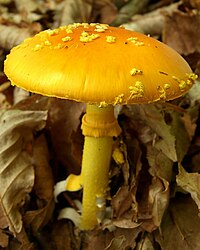 |
| Amanita frostiana | Frost's Amanita | North America |  |
| Amanita nehuta | Mahori dust Amanita | New Zealand |  |
| Amanita parcivolvata | Ringless False Fly Amanita | America |  |
| Amanita parvipantherina | Asian Small Panther Amanita | China | |
| Amanita petalinivolva | South America | ||
| Amanita roseotincta | North America |  | |
| Amanita rubrovolvata | Red volva Amanita | Asia |  |
| Amanita subfrostiana | False Frost's Amanita | China | |
| Amanita velatipes | Veiled-Bulb Amanita | North America |  |
| Amanita viscidolutea | South America | ||
| Amanita wellsii | Wells's Amanita | North America |  |
| Amanita xanthocephala | Vermilion grisette | Australia |  |
| Armillaria mellea [43] | Honey fungus | North America, Europe, Northern Asia and Australia |  |
| Calocera viscosa | Yellow stagshorn | North America, Europe and Asia |  |
| Chlorophyllum brunneum | Shaggy parasol | North America, Europe, Australia and Southern Africa |  |
| Choiromyces venosus | Europe | ||
| Clitocybe fragrans | Europe |  | |
| Clitocybe nebularis | Clouded agaric | North America and Europe |  |
| Conocybe subovalis | Europe | 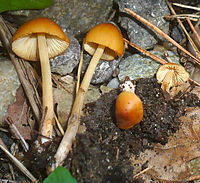 | |
| Coprinellus micaceus | Mica cap | worldwide |  |
| Lactarius chrysorrheus | Yellowdrop milkcap | North America, Europe and North Africa |  |
| Lactarius helvus | Fenugreek milkcap | Europe and Asia |  |
| Lepiota cristata | Stinking dapperling | North America, Europe, Northern Africa, Northern Asia and New Zealand |  |
| Marasmius collinus | Europe | ||
| Russula olivacea [43] | North America, Europe and Asia | 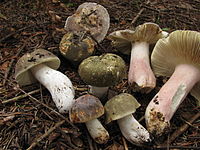 | |
| Russula viscida | Europe |  | |
| Schizophyllum commune | worldwide |  | |
| Stropharia aeruginosa [ citation needed ] | Verdigris agaric | North America and Europe |  |
| Suillus granulatus [43] | Weeping bolete | worldwide |  |
| Tricholoma sulphureum | Gas agaric | Europe and North America |  |

A mushroom or toadstool is the fleshy, spore-bearing fruiting body of a fungus, typically produced above ground, on soil, or on its food source. Toadstool generally denotes one poisonous to humans.

Amanita muscaria, commonly known as the fly agaric or fly amanita, is a basidiomycete of the genus Amanita. It is a large white-gilled, white-spotted, and usually red mushroom.

Amanita phalloides, commonly known as the death cap, is a deadly poisonous basidiomycete fungus, one of many in the genus Amanita. Widely distributed across Europe, but introduced to other parts of the world since the late twentieth century, A. phalloides forms ectomycorrhizas with various broadleaved trees. In some cases, the death cap has been introduced to new regions with the cultivation of non-native species of oak, chestnut, and pine. The large fruiting bodies (mushrooms) appear in summer and autumn; the caps are generally greenish in colour with a white stipe and gills. The cap colour is variable, including white forms, and is thus not a reliable identifier.

Edible mushrooms are the fleshy fruit bodies of several species of macrofungi. Edibility may be defined by criteria including the absence of poisonous effects on humans and desirable taste and aroma. Mushrooms that have a particularly desirable taste are described as "choice". Edible mushrooms are consumed for their nutritional and culinary value. Mushrooms, especially dried shiitake, are sources of umami flavor.

The genus Amanita contains about 600 species of agarics, including some of the most toxic known mushrooms found worldwide, as well as some well-regarded edible species. The genus is responsible for approximately 95% of fatalities resulting from mushroom poisoning, with the death cap accounting for about 50% on its own. The most potent toxin present in these mushrooms is α-Amanitin.

Omphalotus olearius, commonly known as the jack-o'-lantern mushroom, is a poisonous orange gilled mushroom that to an untrained eye appears similar to some chanterelles. It is notable for its bioluminescent properties. It is found in woodland areas in Europe, where it grows on decaying stumps, on buried roots or at the base of hardwood trees. It has also been reported from the Western Cape Province, South Africa. A similar, but phylogenetically distinct species found in eastern North America is Omphalotus illudens.

Mushroom poisoning is poisoning resulting from the ingestion of mushrooms that contain toxic substances. Symptoms can vary from slight gastrointestinal discomfort to death in about 10 days. Mushroom toxins are secondary metabolites produced by the fungus.

Amanita virosa is a species of fungus in the class Agaricomycetes. In the UK, it has the recommended English name of destroying angel and is known internationally as the European destroying angel. Basidiocarps are agaricoid (mushroom-shaped) and pure white with an ring on the stem and a sack-like volva at the base. The species is deadly poisonous. It occurs in Europe and northern Asia. Amanita virosa was formerly reported from North America, but research has shown that similar-looking American species, including Amanita bisporigera and A. ocreata, are distinct.
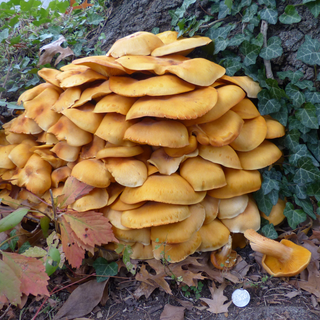
Omphalotus illudens, commonly known as the eastern jack-o'lantern mushroom, is a large, orange mushroom that is often found in clumps on decaying stumps, buried roots, or at the base of hardwood trees in eastern North America. Its gills often exhibit a weak green bioluminescence when fresh. This green glow has been mentioned in several journal articles, which state that the phenomenon can persist up to 40–50 hours after the mushroom has been picked. It is believed that this display serves to attract insects to the mushroom's gills during nighttime, which can then distribute its spores across a wider area.

Agaricus is a genus of mushroom-forming fungi containing both edible and poisonous species, with over 400 members worldwide and possibly again as many disputed or newly-discovered species. The genus includes the common ("button") mushroom and the field mushroom, the dominant cultivated mushrooms of the West.
Amatoxin is the collective name of a subgroup of at least nine related toxic compounds found in three genera of poisonous mushrooms and one species of the genus Pholiotina. Amatoxins are very potent, as little as half a mushroom cap can cause severe liver injury if swallowed.
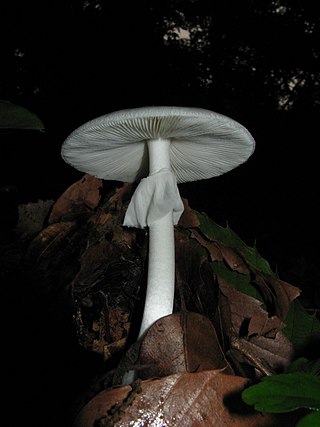
Amanita verna, commonly known as the fool's mushroom or the spring destroying angel, is a deadly poisonous basidiomycete fungus, one of many in the genus Amanita. Occurring in Europe in spring, A. verna associates with various deciduous and coniferous trees. The caps, stipes and gills are all white in colour.

Agaricus campestris is a widely eaten gilled mushroom closely related to the cultivated A. bisporus. A. campestris is commonly known as the field mushroom or, in North America, meadow mushroom.
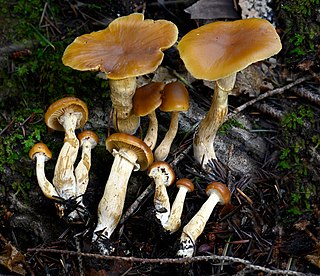
Galerina marginata, known colloquially as funeral bell, deadly skullcap, autumn skullcap or deadly galerina, is a species of extremely poisonous mushroom-forming fungus in the family Hymenogastraceae of the order Agaricales. It contains the same deadly amatoxins found in the death cap. Ingestion in toxic amounts causes severe liver damage with vomiting, diarrhea, hypothermia, and eventual death if not treated rapidly. About ten poisonings have been attributed to the species now grouped as G. marginata over the last century.

Amanita ocreata, commonly known as the death angel, destroying angel, angel of death or more precisely western North American destroying angel, is a deadly poisonous basidiomycete fungus, one of many in the genus Amanita. The large fruiting bodies generally appear in spring; the cap may be white or ochre and often develops a brownish centre, while the stipe, ring, gill and volva are all white. A. ocreata resembles several edible species commonly consumed by humans, increasing the risk of accidental poisoning. Mature fruiting bodies can be confused with the edible A. velosa, A. lanei or Volvopluteus gloiocephalus, while immature specimens may be difficult to distinguish from edible Agaricus mushrooms or puffballs.

Omphalotus nidiformis, or ghost fungus, is a gilled basidiomycete mushroom most notable for its bioluminescent properties. It is known to be found primarily in southern Australia and Tasmania, but was reported from India in 2012 and 2018. The fan or funnel shaped fruit bodies are up to 30 cm (12 in) across, with cream-coloured caps overlain with shades of orange, brown, purple, or bluish-black. The white or cream gills run down the length of the stipe, which is up to 8 cm (3 in) long and tapers in thickness to the base. The fungus is both saprotrophic and parasitic, and its fruit bodies are generally found growing in overlapping clusters on a wide variety of dead or dying trees.

Amanita bisporigera is a deadly poisonous species of fungus in the family Amanitaceae. It is commonly known as the eastern destroying angel amanita, the eastern North American destroying angel or just as the destroying angel, although the fungus shares this latter name with three other lethal white Amanita species, A. ocreata, A. verna and A. virosa. The mushroom has a smooth white cap that can reach up to 10 centimetres across and a stipe up to 14 cm tall with a white skirt-like ring near the top. The bulbous stipe base is covered with a membranous sac-like volva. The white gills are free from attachment to the stalk and crowded closely together. As the species name suggests, A. bisporigera typically bears two spores on the basidia, although this characteristic is not immutable. A. bisporigera closely resembles a few other white amanitas, including the equally deadly A. virosa and A. verna.

Amanita regalis, commonly known as the royal fly agaric or the king of Sweden Amanita, is a species of fungus in the family Amanitaceae. A. regalis has a scabby liver-brown cap and a stem which is yellow-ochre at the base, with patches or rings of patches. The fruit bodies somewhat resemble the smaller A. muscaria, which it was formerly regarded as a variety of.
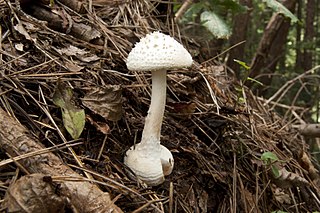
Amanita sphaerobulbosa, commonly known as the Asian abrupt-bulbed Lepidella, is a species of agaric fungus in the family Amanitaceae. First described by mycologist Tsuguo Hongo in 1969, it is found in Southern Asia.
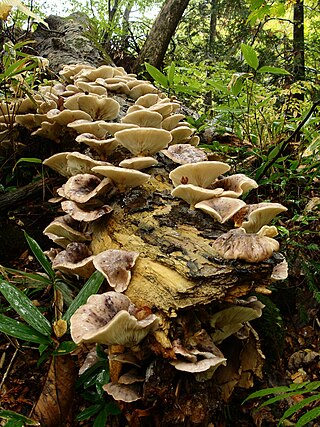
Omphalotus japonicus, commonly known as the tsukiyotake(月夜茸), is an orange to brown-colored gilled mushroom native to Japan and Eastern Asia. It is a member of the cosmopolitan genus Omphalotus, the members of which have bioluminescent fruit bodies which glow in darkness. A 2004 molecular study shows it to be most closely related to a clade composed of Omphalotus nidiformis of Australia, Omphalotus olivascens of Western North America and Omphalotus olearius of Europe.
{{cite book}}: CS1 maint: location missing publisher (link){{cite book}}: CS1 maint: others (link){{cite journal}}: Missing or empty |title= (help){{cite book}}: CS1 maint: multiple names: authors list (link){{cite book}}: CS1 maint: others (link){{cite book}}: CS1 maint: location missing publisher (link)